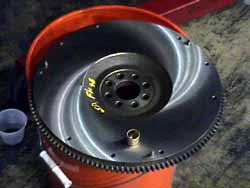Timing:
This should be obvious. When the clutch starts slipping under load, it's time to replace it, unless pedal adjustment will cure the slippage. Keep in mind the flywheel will need to be resurfaced if the clutch assembly is being replaced. This requires machine work available at most auto parts stores during regular business hours. Make sure to call ahead of time to figure out a plan. There are some easily replaceable alternate parts to consider doing at the same time.
Special tools:
Clutch alignment tool
3' long x 1/2" extension
14 mm short socket in 1/2"
1/2" socket swivel
Part numbers:
OEM friction disc
30100-45P01 NA
30100-45P11 TT
OEM pressure plate
30210-30P00 NA 02/89-09/93
30210-45P01 NA 09/93+
30210-45P05 TT
OEM flywheel
12310-30P13 NA 02/89-07/95
12310-54P00 NA 07/95+
12310-30P12 TT 07/89-07/95
12330-54P10 TT 07/95+
30502-45P00 throw out bearing
32202-B9500 pilot bushing
12279-0M300 rear main seal
30537-40P00 clutch fork pivot ball
Alternate replacement parts:
30531-01500 clutch fork
32136-01G10 rear transmission seal TT/NA
O2 sensors (easy to get to with the transmission out)
22690-30P00 NA pass. 2/89-9/93
22690-46P00 NA pass. 9/93+
22690-30P10 NA driver 2/89-9/93
22690-46P10 NA driver 9/93+
22690-30P00 TT pass 7/89-9/93
22690-46P00 TT pass 9/93+
22690-40P10 TT driver 7/89-9/93
22690-48P10 TT driver 9/93+
Procedure:
1. Jack up the car. This can be done on a set of jack stands about 16-18" tall. A lift and a real transmission jack are extremely helpful, but not mandatory. Take all safety precautions necessary. Disconnect the negative terminal of the battery.
2. Remove the rear undercarriage brace (4 x 12 mm bolts). Remove main exhaust (6 x 14 or 13 mm for precats, 2 x 12 mm for hangers & 4 x 17 mm for rear of exhaust). I generally remove the whole center section which is the main exhaust and the H/X/etc pipe right before the mufflers. It's easier to remove those bolts then the ones where the pipes are right next to each other right after the main catalytic convertors.
3. Remove heat shield above the exhaust (4 x 10 mm nuts & 2 x 10 mm bolts).
4. Mark center connection on drive shaft with a paint pen or something of that nature to regain proper alignment for balance when re-assembling.
5. Remove drive shaft by dropping the center support bearing (2 x 17 mm bolts). Don't loose the spacers/washers that go in-between the CSB and the body mounts. Then unbolting the two halves (4 x 17 mm). Manipulating the e-brake with the car in nuetral will allow easy access to all four bolts when the shaft is rotated. Separate the drive shaft halves at the U-joint and pull the front half out of the transmission. Stuff a shop rag in the end of the transmission to catch any fluid.
6. Disconnect the 3 electrical connections on the passenger side of the transmission: the speed sensor, reverse lamp switch and neutral position switch plugs. Loosen the wire harness holders along the way forward on top of the transmission to the engine.
7. Disconnect the shifter support bracket (red dots in 1.) (4 x 12 mm). Disconnect the shifter handle (2 x 12 mm, 1 bolt & 1 nut) (blue dots in 1.) from the shifter linkage on the transmission.
8. Remove the passenger precat. Note: This makes getting the starter out easier and working with the transmission easier as well. Although this step may be skipped. It's advised to have a 14 mm 'stubby' wrench to get to the top starter bolt if the precat is not removed. Remove the battery. Unplug the O2 sensor from the wiring harness on the side of the plenum. Unclip the O2 wire from it's holder on the back corner of the engine so the entire wire is free. Then remove the side heat shield bolt on the precat located adjacent to the top two precat bolts (1 x 10 mm), then the top two 13 mm bolts & finally the bottom two 13 mm nuts. Remove the precat from the turbo. Be careful not to ding the O2 sensor. refer to the Precat Gutting page for more details.
9. Remove the clutch slave cylinder (2 x 14 mm) (2.), loop it back around to hang on the front suspension on it's rubber line to get it out of the way.
10. Remove the power lead to the back of the starter (1 x 12 mm nut) (3.). Disconnect the thin starter relay wire, it's in front of the starter. Remove the wiring bracket on the side of the engine to get the starter off (1 x 10 mm). The back half is under the starter's bolt. If the passenger precat is removed, skip this next part. Unbolt the heat shield 'window' (2 x 10 mm) (4. and the upper bolt is the red dot in 5.). This allows enough space to get the starter around the precat if it's still installed. Remove the starter (2 x 14 mm, 1 nut and 1 bolt) and wiring bracket.
11. Remove the transmission bell housing bolts. This is simplified with a 3' x 1/2" extension, a 1/2" swivel and a short 14 mm 1/2" socket. Put a floor jack's lift cup under the transmission drain plug to hold the transmission in place. This is roughly the balance point for the entire weight of the transmission, keep it here to make the next step work out properly. Remove the bolts on the driver side of the transmission mount (3 x 14 mm bolts) (green dots in 1. on the left), slightly loosen the 3 bolts on the passenger side (3 x 14 mm bolts) (green dots in 1. on the right). Slowly lower the transmission until the mount drops as far as the bolts allow it to. Keep the jack in place to support the transmission's weight. This give just enough space to get the extension up to the top bolt on the driver side. Picture 1. illustrates. The angle is with the extension going in just ahead of the rear transmission mount. Remove all 10 bolts. The topmost bolt on the passenger side has the battery ground loop on it (blue dot in 7.). Some bolts go from the engine into the transmission as well.
12. Lift the transmission back up with the jack. Remove the lower bell housing front plate so it doesn't fall out when removing the transmission. Remove the other 3 mount bolts (3 x 14 mm bolts) (green dots in 1. on the right). The transmission is basically held up by the jack and where the main shaft is going into the pilot bushing on the rear of the crank. I can do this without a transmission jack or any straps etc. If things feel uncomfortable, please use whatever safety straps, etc. need to get the confidence level up. Understand the transmission has to come straight back about 6" before it can be lowered. The transmission weighs about 85 lbs wet and if done properly, the jack will do all the work of lowering it down. Otherwise it could cause serious injury if it's allowed to fall. It's a process of the assistant slowly lowering the jack a little bit at a time, while the transmission is slowly pulled backwards. Be very careful, as the speed sensor (the black short round thing sticking out of the top side of the transmission) will definitely try to smash into the transmission hump. Keep an eye on it and if it's clearing, then everything else should work out. The transmission will finally get free of the engine. Pull the transmission backward until there's about 2' of clearance in the front side. This should be enough room to work on the clutch etc. without having to get the transmission off the jack and out from under the car. Note: I cannot stress enough how something this simple can be extremely dangerous. Consider dropping an 85 lb weight directly on anything close by and what injury could result from having it drop on an arm, leg, or a head. Again, if this is uncomfortable, add straps, blocks, a real transmission jack, whatever it takes to make the work space safe for everyone involved.
13. With the jack lowered all the way, block up the transmission so it won't roll off the jack, they like rolling over on the passenger side. Remove the fork (green dot in 6.) and throw out bearing assembly (red dot in 6.), pay attention to how the spring clips on the fork are holding things in place. Remove the pivot ball under the fork (blue arrow in 6.) (1 x 17 mm). Press the bearing out of the throw out hub in a vice. Press the new throw out bearing in place, making sure it's going right side on. Use a large socket to carefully tap the bearings in & out. Make sure it rotates easily after installing.
14. Replace the pivot ball (1 x 17 mm). Torque to 21 ft-lbs. Lubricate the ball end with lithium grease. Fill the shallow groove area on the throw out bearing assembly with lithium grease. Do not use too much, just make the inside diameter smooth with extra grease. Over lubrication will get slung somewhere in the bell housing and the #1 location is onto the clutch assembly. Absolutely not good. Reassemble the fork/pivot ball/throw out bearing making sure all the spring clips are back in place. One clamps on the pivot ball in the fork and the other holds the throw out bearing assembly on the fork.
15. Remove the pressure plate and friction disk on the clutch (red dot in 7.) (9 x 12 mm bolts). be careful, there's 3 small dowel pins holding it in place on the flywheel (green dot in 7.), but once the bolts are out, the pressure plate will want to push off of the flywheel & fall off. Be ready for things to fall out and hit the floor, try to keep anything from doing just that. Remove the pressure plate and friction disk. Also, if using air tools, then the bolts should all break loose easily. If not, then put a 27 mm socket on the crank pulley bolt on the front of the engine and a long wrench handle to hit the floor (if on jack stands), or get someone else to hold the crank in place if on a lift.
16. Remove the flywheel (8 x 14 mm bolts) (green dot in 7.) (8.). It's sitting on the rear of the crank and won't fall directly off. Be very careful again, as the OEM flywheel weights 23 lbs and has the starter gear teeth on it. It's easy to get cut by them if the flywheel tries to fall off. Remove the flywheel.
17. Use a small chisel and cut the bronze pilot bushing into several smaller sections until it basically crumbles and falls out. I use a mild steel chisel, which is much harder then the pilot bushing, but much softer then the crank. The chisel is used to cut slots in the bushing until it collapses. The bronze is very brittle and will break after some abuse. Use brake cleaner to wash all the old bushing remnants out. Test fit the bushing on the main shaft of the transmission. Sometimes they fit better one direction then the other. Orient it the same going into the crank so the main shaft will fit as easily a possible. Press the new bushing into the rear of the crank using a similar diameter socket. Note: it's roughly 14 mm. I use a 1/2 to 3/8 socket adapter as my punch tool.. Once it's started in the hole, use a plastic hammer face to tap the bushing in until it's flush with the edge of the hole's inner chamfer, it can be pushed too far back into the crank. Note: the copper is very soft and will easily distort is struck too hard or a metal hammer is used. Put a thin coat of lithium grease on the inside of the bushing.
18. Use a small straight blade screwdriver and tap it in-between the top of the block and the rear main seal (9.). Gentle pry the seal out. It comes out surprisingly easily. Make certain to not scratch the crank's sealing surface. Rub the new rear main seal in motor oil inside and out. Replace the seal and gently tap it into it's seat with a small punch. Make sure the retaining spring inside the seal doesn't come out while pressing it in place & don't scratch the sealing surface on the crank. That would be an expensive mistake!
19. If the large backing plate came off the back of the engine, make sure it goes back on now, right side up & front side front (9.) hanging off the two alignment guides.
20. If reinstalling the stock flywheel, it needs to be resurfaced with the same .008" step for TTs (slightly visible in 10.) and flat surface for NAs (11.) before putting a new clutch on it. Unless the friction parts aren't being replaced (just doing rear main & not replacing either clutch component). Hang the flywheel on the rear of the crank and start threading the bolts on it (8 x 14 mm). Clean the flywheel off with brake cleaner and a clean towel (10.). Keep wiping until all the assembly lube is removed from it. The part is generally coated with a light oil to keep it from rusting. Torque to 61-69 ft-lbs in a skip 2 pattern, make multiple rotations to make sure all bolts are correctly torqued. Put a 27 mm socket on the crank pulley bolt on the front of the engine and a long wrench handle to hit the floor (if on jack stands), or get someone else to hold the crank in place on a lift. Leave the wrench on the front for the next step.
21. Clean off the pressure plate face with brake cleaner and a clean towel. Keep wiping until all the assembly lube is removed from it (just like the flywheel). Stick the plastic clutch disk alignment tool in the friction disk, hang the friction disk out of the pilot bushing by the plastic alignment tool. The springs, etc on the friction disk stick out toward the back of the car. Put the pressure plate on the flywheel, it will only go on in one direction because of the 3 small dowell pins. Start the 9 bolts to hold the collection to the flywheel. Tighten the bolts in a skip 2/2/3 pattern (9 x 12 mm). Make several rounds before torqueing to 25-33 ft-lbs. Remove the plastic alignment tool (should slide out easily).
22. Start lifting the transmission back up into place like it was removed. Once the transmission main shaft starts getting close to going into the clutch assembly, it will have to be 'stabbed', meaning the 85 lb transmission's mainshaft will have to be blindly pushed into the pilot bushing. Not nearly as easy as it might sound. The fit is very low tolerance and the shaft is long enough to necessitate almost a direct shot to make it work. Sometimes the engine leans forward when the transmission's out making this harder, sometimes it leans back, etc. In general a second jack will become useful in helping get the angle correct, careful used of the spare tire scissor jack will do fine. Be patient this is the hardest part of the job. When the transmission gets stabbed, it will be obvious as it will go in another 1" or so and close the distance from the transmission's bell housing to the engine's rear mounts.
23. The front of the transmission should be held in place like it had been earlier, by the main shaft in the pilot bushing. Bolt up the passenger side of the transmission mount loosely & allow it to hang like it had when removing the front mounting bolts.
24. There are 8 bolts of varying length. Line them up and check them
according to the diagram and table:
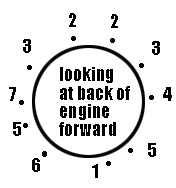 |
Bolt | Torque ft-lbs. | Length mm (in) |
| 1 | 29-36 | 100 (3.94) | |
| 2 | 29-36 | 55 (2.17) | |
| 3 | 29-36 | 60 (2.36) | |
| 4 | 22-29 | 55 (2.17) | |
| 5 | 29-36 | 25 (0.98) | |
| 6 | 22-29 | 60 (2.36) | |
| 7 | 29-36 | 65 (2.56) |
Get the transmission bolted and torqued back on the engine. Don't forget to get the battery ground loop on it (blue dot in 7.) back on the top right bolt. Make sure the shifter support bracket is on top of the ears on the rear of the transmission and the pivoting nut plates are both down. Jack the transmission back up and get the rest of the mount bolts in (3 x 14 mm). Torque all six to 38-48 ft-lbs.
25. Reconnect the electrical sensors on the right side of the transmission (3 plugs). Catch the harness in the holding loops on top of the transmission. Bolt the shifter support bracket back to the transmission ears (4 x 12 mm bolts). Torque to 9-12 ft-lbs. If new shifter bushings were purchased, remove the old ones from the shifter handle. Bolt the shifter handle back to the shifter linkage on the transmission (2 x 12 mm, 1 bolt & 1 nut) (blue dots in 1.). Torque to 12-14 ft-lbs
26. Replace the starter (2 x 14 mm, 1 nut and 1 bolt). I could not find a torque spec in the service manual. If one is found, please e-mail me with it! The best I can think of is 25-35 ft-lbs. Make sure to catch the electrical harness bracket back under the nut. Connect the electricals: the power lead (1 x 12 mm nut) (3.), the thin starter relay wire. Bolt the heat shield window back in place (2 x 10 mm bolts) if it was removed.
27. Replace the passenger side precat and O2 sensor assembly if it was removed. (4 x 13 mm, 2 bolts, 2 nuts). Reconnect and re-clip the O2 sensor.
28. Replace the clutch slave cylinder (2 x 14 mm bolts). Torque to 22-30 ft-lbs.
29. If replacing the rear seal on the transmission, do it now (yellow dot in 1.). Replace the drive shaft (4 x 17 mm), make sure the alignment marks are in the proper place. Torque the drive shaft bolts to 29-33 ft-lbs for the NA drive shaft and 40-47 ft-lbs for the TT drive shaft. Bolt the CSB back in place. Don't forget the spacers that go in-between the CSB and the body mounts. Torque the CSB bolts to 43-58 ft-lbs.
30. Replace the heat shield (4 x 10 mm nuts & 2 x 10 mm bolts).
31. Replace the main exhaust (6 x 14 or 13 mm, 2 x 12 mm & 4 x 17 mm) using new gaskets, reusable metal gaskets or Permatex Copper Ultra Seal silicon. Torque the front nuts to 33-37 ft-lbs, the rear nuts to 32-41 ft-lbs. Replace the undercarriage brace (4 x 12 mm bolts).
32. Lower the car back to the ground, reconnect the negative terminal of the battery.
33. The clutch pedal will more then likely have to be adjusted afterwards, it will probably be engaging right off the floor.
Published 11-17-2000
Revised 10-22-2003
© Twin Turbo Zs of Dallas - All Rights Reserved 2003
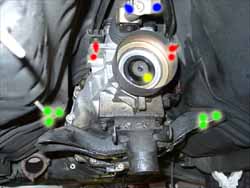
2.
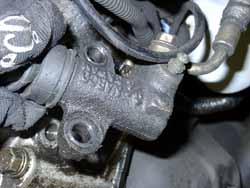
3.
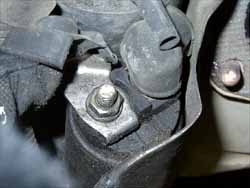
4.
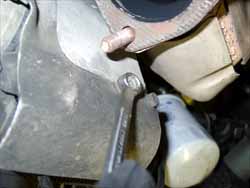
5.
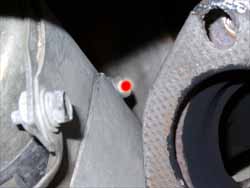
6.
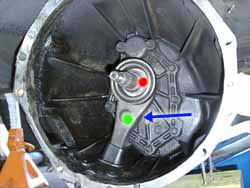
7.
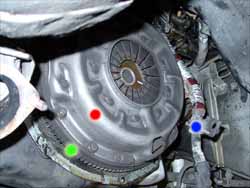
8.
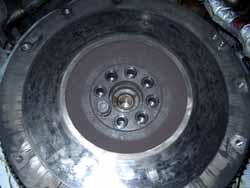
9.
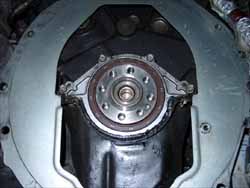
10.
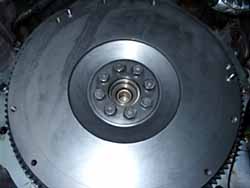
11.
